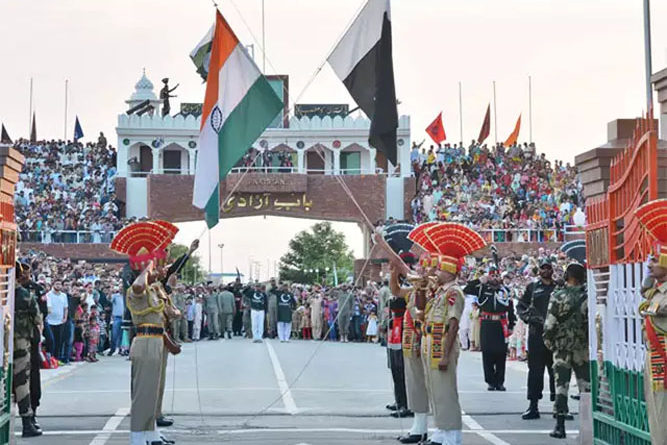China, FATF or Biden: What Made India & Pakistan Agree To Complete Ceasefire Along The LoC
March 1, 2021
Pakistan’s compulsions and India’s predicament may have prompted the two countries to jointly declare a ceasefire along the Line of Control (LoC), their de facto border in Jammu and Kashmir.
On February 25, the armies of the two countries announced they had started maintaining a ceasefire along the LoC from the midnight of February 24.
Coming on the second anniversary of border skirmishes that led the two nuclear-armed neighbors to the brink of war, the latest development is indeed a welcome move.
While peace-loving citizens on both sides of the divide would want this arrangement to last, one must not forget history, especially Pakistan’s track record of adhering (violating) to the ceasefire norm.
Pakistan was quick to disclose that the surprise development, if one may like to call it, is the outcome of “behind-the-scenes” contacts and “more roads will open” in the future.
It is believed India’s National Security Advisor Ajit Doval and Pakistan Prime Minister Imran Khan’s adviser on security affairs, Moeed Yusuf, had held back-channel parleys to come to this agreement.
There is also speculation that Washington may have played a role to reduce tensions between the two South Asian neighbors. Regardless of such possibilities, there is a scope to dip digger to see what prompted New Delhi and Islamabad to “hold fire”.
Pakistan’s Compulsions
In December, Indian media reported quoting security officials that the year 2020 had witnessed 5,100 instances of ceasefire violations by Pakistan along LoC, the highest since the 2003 truce announced by both sides. As many as 36 people were killed, more than 130 injured in these incidents.
In October, India’s Ministry of External Affairs had said Pakistan’s “unprovoked ceasefire violations” were aimed at supporting “infiltration of terrorists across LoC”.
The accusation came at a time when the global watchdog Financial Action Task (FATF) Force was holding its plenary meeting, which was looking at Pakistan’s compliance with a 27-point action plan on terror financing.
And obviously, Islamabad was woefully short of meeting these targets. Perhaps this is the reason why the Paris-headquartered FATF then decided to keep Pakistan in its ‘grey list’ until February this year.
The grey list includes nations that present significant risks of money laundering and terror-financing, but have shown the potential of committing to working closely to address their deficiencies.
In its latest evaluation, FATF once again caught Pakistan on the wrong foot and decided to further extend its grey-listing until June this year.
“Pakistan will remain under increased monitoring as serious deficiencies remain related to terror financing. While Pakistan has taken important steps, there are 3 important points from 27 action points remaining to be acted upon,” FATF President Marcus Pleyer said at a press briefing last week.
As highlighted by The Eurasian Times, Pakistan has also failed to take action against UN-designated terrorists ‘hiding’ in the country. They include Jaish-e-Mohammed (JeM) chief Masood Azhar, Lashkar-e-Taiba (LeT) founder Hafiz Seed, and Zakiur Rehman Lakhvi, the LeT’s operational commander.
Azhar, Saeed, and Lakhvi are the most-wanted terrorists in India for their involvement in numerous terrorist acts, including the 26/11 Mumbai terror attacks and the 2019 bombing of a CRPF bus in Jammu and Kashmir’s Pulwama.
It’s clear that FATF is aware of these matters and decided to tighten the noose around Pakistan. Interestingly, in the wake of the FATF decision, Pakistan PM Imran Khan has said international organizations dealing with tax matters and illicit financing should not be used as instruments of pressure on developing countries.
His comments indicate that Islamabad did feel the pressure to show some action and probably this is why it felt the urge to lower the hostilities on the border, which are anyway a cover to help terrorists infiltrate into India’s Jammu and Kashmir.
India’s Predicament
The ceasefire agreement came within days of India and China completing the disengagement process in the Pangong Tso in eastern Ladakh.
It brought to an end one of the longest military standoffs between the two countries. It had also witnessed a bloody clash between the two armies.
India lost 20 of its soldiers and China recently admitted that four PLA personnel were killed in the Galwan Valley incident on June 15 last year.
With the border standoff with China over, India probably decided to reduce tensions with Pakistan as well. There is speculation that India might have been looking for some kind of a “package deal” to stabilize relations simultaneously with two hostile neighbors, who are also ‘iron brothers’.
It must be noted that the India-Pakistan ceasefire announcement came just hours before India’s External Affairs Minister S. Jaishankar had a 75-minute-long phone conversation with his Chinese counterpart Wang Yi during which the former stressed that following the disengagement at the Pangong Tso, “both sides should now quickly resolve the remaining issues along the LAC in Eastern Ladakh,” according to an External Affairs Ministry statement.
A major takeaway from this discussion was that the two sides agreed to “establish a hotline”. But how is this related to India’s ceasefire decision with Pakistan?
“The government of India perhaps decided to make sure that at least one front is diffused, that is, Pakistan. And then negotiations with China happened,” Happymon Jacob, professor at Jawaharlal Nehru University, told The Hindu.
While some analysts may see the ceasefire agreement as a “climbdown” from India’s previous position of not talking to Pakistan unless it stopped supporting terrorism, only time will tell if New Delhi has done the right thing or not.
Courtesy: Eurasian Times

